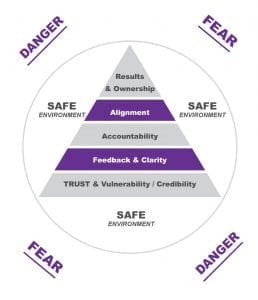The value of alignment

How often do leaders and teams find working together to achieve a mutual outcome, challenging?
In order to get results and performance, leaders try to drive activities with task lists and the application of technical expertise. Still there are errors, time wasters, unhappy people, unhappy customers, poor customer experience, internal team stress and a tight grip of control to get things done. The culture becomes one that is fear driven with low trust.
Sound like your world?
Don’t feel alone. We work with many leaders and teams who have similar challenges and yes, there is light at the end of the tunnel. You could train, coach and council as much as you like, but without personal ownership this intervention will be just another expense to add to the organisation is income statement. Unfortunately it will drive low returns on the investment dollar, and frustrate people when things remain the same.
There are two topics around Alignment and Performance I’d like to cover in this overview:
- Your people and their commitment to the result which drives performance
- The Performance Model
Your people and their commitment to the result which drives performance:
When people are unhappy, feel unsafe and insecure, feel unheard, don’t get enough attention, are not purposeful, don’t feel connected with their leader and the team, they will act out. In the work we do with client organisations we see many challenges:
- There is a ‘fear’ culture in the business and this creates anxiety and can slow or even derail performance versus getting performance right.
- New people are not effectively on boarded and aligned to the new role and organisation. Remember they are new, this is very important, even though they are highly skilled they need to know how to be successful in your world.
- Leaders don’t make time to connect with their people, time leadership is everyone’s challenge, prioritise your people.
- Feedback is used as a stick to discipline versus a tool to empower ownership and alignment. Feedback needs to be timely and remember it’s not the person you are addressing it’s the impact of their behaviour, situation or issue. Always seek clarity to make sure you understand all sides.
- People simply misunderstand each other but don’t have the courage or trust to discus things. Without communication and understanding what makes you and others tick you will figure some things out intuitively but might still not know how to communicate in way the other person understands.
- Individuals are set up to fail by leaders who direct and don’t coach. Feedback and clarity is rarely sought – coaching and feedback are two different activities. If people don’t get coaching they don’t develop, if you only provide feedback development is stunted and you might end up working longer hours and have people who are not empowered and will be less willing to make decisions for themselves. Coach to develop, provide feedback to correct or encourage.
- Low self awareness, this is where individuals don’t realise or own their behaviours and how these behaviours are impacting their leaders and their team. This can be very frustrating and stressful for members within a team and also for leaders managing a team. Stress causes low communication, drives misunderstanding, low trust and blame. Awareness needs to be addressed quickly as long term behaviours if accepted become the norm which in turn impacts a performance culture.
Have you asked yourself the questions
• Do they trust me? What does trust look like to them?
• Did you know that every time you engage with people they assess how you make them feel and how credible you are in their eyes?
• Am I showing my vulnerability? Showing measured vulnerability allows others to see your strengths and that you see your own weaknesses (you are human).
What is the answer?
Firstly leaders need to understand the basis of performance improvement and taking ownership for the culture they are creating. This ownership then moves to the team and together they are able to align and drive performance.
The Performance Model
 In our work with our clients we use various tools to support people and shift performance. One of the models we use on a regular basis is “The Performance Model”. This model allows you to consider a step by step approach to driving performance.
In our work with our clients we use various tools to support people and shift performance. One of the models we use on a regular basis is “The Performance Model”. This model allows you to consider a step by step approach to driving performance.
1. Create a safe environment for your team and business
This doesn’t mean you don’t hold others accountable or challenge behaviours to drive performance. You simply create an environment where you as the leader are credible and where people feel safe and are open to align and work together to achieve performance!
2. Build Trust, Credibility and show Vulnerability
How often have you tried to provide feedback, coach or even support someone in the team and the results have been minimal?3. Feedback and clarity
In a safe environment, where there is trust, credibility and vulnerability you will have earned the right to provide feedback and gain clarity. You will be able to have a courageous conversation and you have earned the right to be listened to and to get a good idea on what the situation looks like from a different perspective. A key competency to develop in this area is leadership courage and to challenge your intention.
4. Accountability
When we are able to provide feedback and create clarity then it is much easier to gain agreement on the way forward and to accept responsibility and to agree on positive solutions, actions and outcomes.
5. Alignment
When solutions are agreed on then alignment is achieved and parties need to once again ensure they are working toward a common goal and are clear on the purpose if that has shifted at all during the process of accountability and feedback. Open communication and honesty is critical. I have seen and experienced that when there is a common goal, and a strong partnership future success is realised.
6. Results
When we are able to orchestrate the previous steps well, we are able to shift behaviours, set expectations and engage people to be purposeful and committed. That is when we have achieved engagement of hearts and minds. That’s when ownership takes place. That’s when results are greater than what we thought possible.
When you and your people are aligned the drive to achieve performance becomes much easier. Leaders don’t have to be control freaks, people are clear on their purpose, measures of success and how to play together. There is a free flow of communication, mutual respect and a culture of performance.
In our endeavour to help our clients to achieve outcomes we recommend the use of:
– behaviour profiling
– strategy and alignment workshops
– mapping ways of working
– simulations
– skills programs
– executive and team coaching



